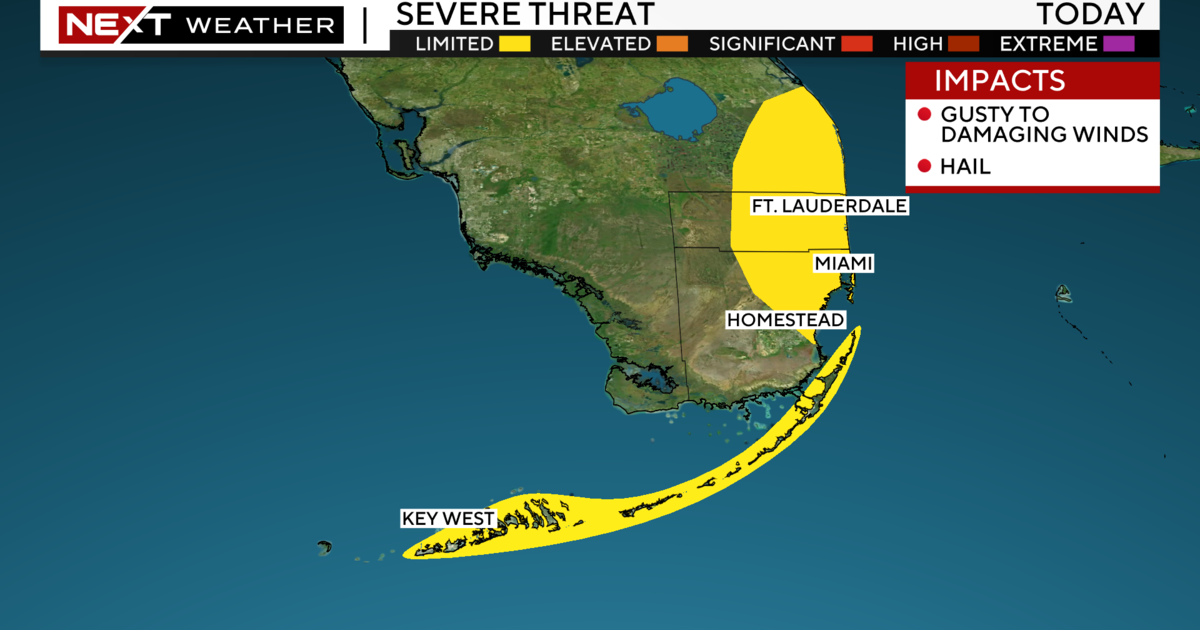Hurricane Season Hits Peak, NOAA Predicts Good Chance For Above Normal Second Half
MIAMI (CBSMiami) - Today, September 10th, is the so-called peak of the Atlantic hurricane season.
With Hurricane Dorian in our rearview mirror, you may think it's all downhill from here.
Not so fast, according to the National Oceanic and Atmospheric Administration (NOAA) which said there's a good chance that there will be more storm development in the Atlantic than usual in the coming weeks.
In August, NOAA forecasters predicted a 45 percent chance that hurricane activity for the rest of the season would be above normal. The chances for a near-normal season were at 35 percent, while a below-normal season was 20 percent.
So what's considered normal?
According to NOAA, the Atlantic hurricane season produces 12 named storms on average. A storm gets a name when it becomes a tropical storm, with sustained winds of 39 mph or greater.
Six of those named storms typically become hurricanes, with wind speeds of 74 mph or more. About three become major hurricanes, with wind speeds of 111 mph or greater.
This season, NOAA predicted that there would be 10 to 17 named storms and that five to nine of them would become hurricanes.
As things stand now, there have been seven named storms: Andrea, Barry, Chantal, Dorian, Erin, Fernand and Gabrielle.
Two of them, Barry and Dorian, strengthened into hurricanes. Dorian has been the only major hurricane so far, slamming into the Bahamas with sustained winds of 185 mph and gusts reaching 200 mph.
Why hurricanes are expected to ramp up
The reason there will likely be more storms in the weeks ahead is that the weather phenomenon known as El Niño has ended.
El Niño refers to a warming of the eastern Pacific Ocean, mainly along the Equator. During an El Niño, there are more storms and hurricanes in the eastern Pacific. But the effect in the Atlantic is the opposite, decreasing the chances a hurricane will form.
"El Niño typically suppresses Atlantic hurricane activity but now that it's gone, we could see a busier season ahead," Gerry Bell, lead seasonal hurricane forecaster at NOAA's Climate Prediction Center, said in a news release. "This evolution, combined with the more conducive conditions associated with the ongoing high-activity era for Atlantic hurricanes that began in 1995, increases the likelihood of above-normal activity this year."
Bell is referring to the 1995 Atlantic hurricane season, which saw eight tropical cyclones and 11 hurricanes. It's considered to be the start of an ongoing era of high activity for tropical cyclones and hurricanes in the Atlantic basin.
Some of the worst hurricanes happened in September and October
If past years are any indication, the worst could be yet to come. Some of the most memorable hurricanes in recent history happened in September and October.
Hurricane Michael barreled into the Florida Panhandle in October 2018, becoming the strongest hurricane to hit the continental US since Andrew in 1992.
In September 2017, Hurricane Maria made landfall in the Caribbean island nation of Dominica and later in Puerto Rico. The storm left about 3,000 people dead and devastated the US territory.
In October 2012, Hurricane Sandy hit the Bahamas, Cuba, Haiti, Jamaica and Puerto Rico, before slamming into the Jersey Shore and wreaking havoc in New York and New Jersey. Sandy left more than 100 people dead and caused about $70 billion in damages, making it the fourth-costliest storm in US history behind Katrina, Harvey and Maria.
And in October 2005, Hurricane Wilma made landfall over Cozumel, Mexico, and later near Cape Romano, Florida. The storm killed 23 people and caused about $20 billion of damage in the US.
(©2019 CBS Broadcasting Inc. All Rights Reserved. Cable News Network, Inc., a Time Warner Company, contributed to this report.)



